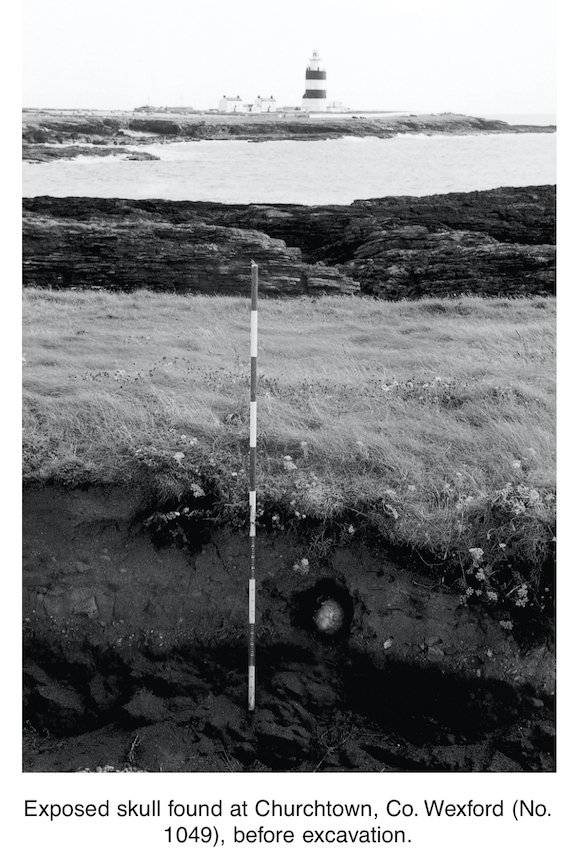County: Wexford Site name: CHURCHTOWN
Sites and Monuments Record No.: N/A Licence number: 00E0872
Author: Karl Brady and Connie Kelleher, Underwater Archaeological Unit, Dúchas
Site type: Burial
Period/Dating: Undetermined
ITM: E 673533m, N 598630m
Latitude, Longitude (decimal degrees): 52.134643, -6.925869
In September 2000 the Underwater Archaeological Unit of Dúchas The Heritage Service undertook a rescue excavation of human remains from a low sea cliff in Little Cove in the townland of Churchtown on the Hook Peninsula, Co. Wexford. The exposed skull was discovered by fossil collectors, who reported it to the local Gardaí. On inspection of the site, it was obvious that the skull was under threat from the encroaching sea and had to be removed.
The area around the skull had been partially exposed by the fossil collectors, placing it under further threat. The remains were located 0.55m below ground surface and lay in a supine position, with the skull gently tilting to the south-west but the skeleton appearing to be buried in a north–south direction. A small aperture was evident in the left side of the skull; it had been exposed for some time to the elements, as indicated by its bleached condition and greenish colour as a result of algae growth. Two layers of loose, gritty soil with some shell and stone inclusions covered the remains, which lay on the bedrock.
The skull and mandible were easily removed and were largely intact. The upper five cervical vertebrae were also removed. There was slight to moderate wear on the teeth, though some chipping was evident (Laureen Buckley, pers. comm.) The skull was identified as male, with prominent brow ridges. Age determination was difficult because of the lack of full skeletal remains. However, the suture closure of the skull would place the individual in the broad age bracket of 21–40 years at time of death. The lack of caries in the teeth would also suggest that the individual is of medieval date or earlier.
The location of the human remains in such a coastal position may indicate the burial of a sailor, pirate or a victim of a shipwreck washed ashore. Shipwreck victims were very often buried close to where they were washed ashore, usually in unconsecrated burial-grounds. However, as the burial occurs in the townland of Churchtown, quite close to another burial-ground at Hook Church (SMR 54:9) and the medieval lighthouse at Hook Head, it is possible that the burial may represent more widespread activity during the medieval period.
The site was stabilised following removal of the skull and will be subject to regular inspection to monitor any further erosion.

6 Ely Place Upper, Dublin 2